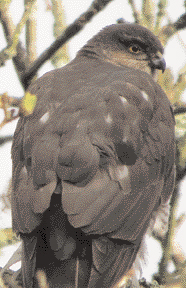|
Wildlife
Newsletter for the Township of Dalkey June 2014 - Michael Ryan |
| The
second of May had a very welcome visitor on the hill when the call of
a cuckoo rang out from the Monterey Pines near the aircraft beacon.
Managed to get a brief glimpse of him (it’s only the males that
have the distinctive call) flying from one tree to another, its shape
in profile very similar to a raptor with long body and tail and pointed
wings. Its shape combined with its grey plumage and barred chest makes
its resemblance to a SparrowHawk almost no accident and certainly a
function of its design and it is thought that since small birds will
fly up and ‘mob’ birds of prey they mistake the cuckoo for
a hawk and fly up, thus revealing where their nest is and showing the
female cuckoo where to lay its egg. It’s a theory and probably
unproven but an interesting thought and for a bird species that has
evolved to get other birds to bring up its young and for the subsequent
offspring then to be able to migrate to Africa alone, without possibly
ever seeing another cuckoo, to devise plumage to fool possible foster
parents doesn’t seem such a big leap. We were going away for a
few days the following day so I don’t know how long the cuckoo
stayed around but the absence of its most common host species the Meadow
Pipit and the non-appearance of any female cuckoos would probably drive
it further inland. Hopefully it looks like a record year for Ladybirds
which appeared in spectacular numbers from early April and at one stage
on Dalkey Hill every second nettle leaf seemed to have a ladybird on
its surface. These ladybirds have survived winter hibernation and will lay eggs on those nettles leaves. When the ladybird larvae hatch they will feed on aphids which also inhabit the nettles. The ladybirds’ ability to consume vast numbers of aphids is why they’ve gained their reputation as the gardeners’ friend. The larvae themselves don’t much resemble the adults, being dark grey with segmented bodies with some orange spots on each side, described very aptly as like tiny alligators, so if you think you have a exotic pest make sure it’s not a ladybird larva before you might think of destroying it. Later in the year nettles will be host plants for a number of butterfly species which will lay eggs on them. The eggs will then develop into caterpillars feeding on the nettles themselves as they grow. The nettles stinging hairs protect them from being eaten by only the hardiest of animals (goats!) so any insect that lives on them has little chance of ending up inside a cow which is probably why nettles support over 40 species of insects. Nettles, although a very valuable plant for wildlife, are not always a welcome addition to gardens. |
 Female Sparrowhawk on Dalkey Hill |
Some
nettles self-seeded in our garden where I left them to aid the insects
but now find I have waist high clumps of them in places since they can
rapidly become very invasive, spreading by root and seed. If you do
cultivate nettles keep them restricted to one area or ideally grow them
in a container where they won’t spread by root. Don’t know
if it has any factual basis but it is said nettle stings are good for
counteracting arthritis so there’s another potential benefit of
having them around We’d been watching a female SparrowHawk perched in a tree when a male SparrowHawk flew in and mated with her, a action that only takes seconds and is usually preceded by the male, with head bowed, making soft mewing calls to the potential mate. They perched close together in the tree for a while after then the male flew to a conifer just above us and landed near a bunch of twigs which subsequently became their nest since the following weekend we saw the female sitting on it. Less than 50 yards away we’d previously spotted a Jay and saw that it was bringing food to its partner in a nest. The two nests were, and at time of writing still are, in very close proximity to each other which you’d imagine wouldn’t be a good idea since the jays are one of the biggest predators on SparrowHawk’s eggs and conversely the SparrowHawks would be well capable of catching young jays. |
| A
friend suggested their proximity to each other might have a mutual benefit
through an unspoken alliance which would increase their chances of defending
their eggs and chicks from other predator birds like hooded crows or
magpies. The ravens nested successfully again this year, same garden
as last year but different tree. At time of writing the young ravens
are flying competently though landing awkwardly but still returning
to the nest. Haven’t yet seen or heard a Whitethroat below the
Vico Road this year but got very reliable reports of Sedge Warbler and
Grasshopper Warbler being seen and heard down there, two species I’ve
never seen known to be there before, so let’s hope |
|